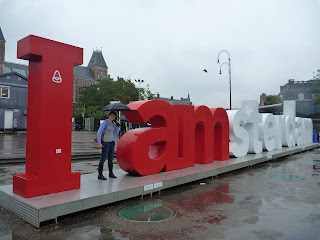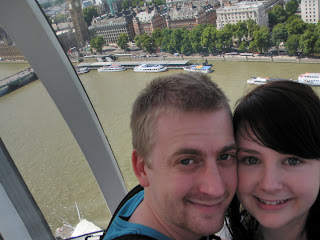Our next adventure began on Busabout, which we were looking forward to after hearing lots of good comments from people. We amended our itinerary a couple of months ago to include Bruge in Belgium, and I’d highly recommend stopping there, as it is a nice break from the big cities.
Probably the only time you may have heard of Bruge is from the recent satirical movie ‘In Bruge’ featuring Colin Farrell. The town acknowledges that this was its big break, with posters of the movie in many shop windows and noticeboards. Bruge is a very quaint European town – while most of the buildings look really old, the churches and town hall had either been burned down in the past or wiped out during one of several invasions by the French. Most of the buildings were built in the 18th or 19th centuries and designed to look a lot older. The town is surrounded by a wall and the streets are paved with cobblestones. The Belgians were really friendly and spoke perfect English, which we really appreciated.
Picturesque Bruge
Belgium is known for chocolate pralines and many types of beer and we certainly weren’t disappointed! I even started to get a taste for beer, trying cherry and raspberry bear. You can get almost any flavour of beer in Belgium, including honey and mango flavour. The chocolate pralines were unforgettable, so I indulged in a couple of packets with Dan’s help (well, he ate one or two under the pretence of me ‘sharing’ with him).
Our hostel, Snuffle Backpackers, had to be our best hostel so far. We had a great night our first night there, drinking cheap beers with around 10 other travellers, including the usual assortment of Aussies, Kiwis and Canadians as well as a Mexican, local Belgians and a Swede. Our bartender PJ even took us to the popular local hangout for Belgians later in the night. After getting some Belgian fries late at night, we sat in the town square and watched as a bucks party with a guy dressed as a smurf was chased around with a broomstick by another guy dressed as a goblin… ah, European craziness!
The highlight of Bruge was definitely the bike tour through the city. As many of you know, I am very anti-cycling at home, but I am quite enjoying cycling in Europe, due to the very flat terrain, bike lanes and no need to wear a helmet! We learned all about the history of Bruge from our local guide, including wars and rebellions, trading history and visited local landmarks like Lover’s Lake. I was excited to see about 20 pure white swans nesting along the side of a river, but this excitement dwindled when we were told the swans' wings had been clipped so they couldn’t fly away. “But they’re really really happy here!” insisted our guide.
Bruge waterways
After farewelling Belgian hospitality, we said hello to the city of Amsterdam, where you can cultivate your own marijuana plants, indulge in cookies, brownies and joints in ‘coffee shops’ and even have sex in public (in a certain city park) without breaking the law. We stayed at an Irish hostel right in the middle of the Red Light District, so after arriving at about 8.30pm, we dumped our bags and set off to see the sights. After walking about 20 metres we saw our first set of red light windows with ladies offering their ‘services’. Tempting as it was when one of these ladies beckoned for both Dan and I to join in a threesome with her (I’m kidding about the tempting bit), we politely declined and kept walking. We also witnessed what happens when someone tries to take a photo of the prostitutes in the windows, with the ladies opening their doors, screaming and throwing water and other small objects at the offenders. They then returned to their windows smiling demurely. On our second night, we decided to go to a show at Casa Rosso. I won’t elaborate here what that involved, but let’s just say it definitely expanded my horizons, as I learned just what you can do with a banana, other than eat it.
Living the hostel life! And using Dan's netbook, which has been invaluable.
Amsterdam canal
Moving away from the Red Light District, we did experience the real culture of Amsterdam. One of the real highlights for me was visiting the Anne Frank House. The Anne Frank Foundation, first started by Otto Frank, Anne's father, has fully preserved the Secret Annexe where the Jewish Frank family hid for two years in the middle of Amsterdam during World War II before being discovered and sent to Concentration Camps by the SS. Walking through the Annexe was really eerie - they have preserved the wallpaper with the photographs that Anne pasted onto the walls. You could also see the attic where Anne and Peter used to sit and look out the window at the hundreds of other Jews being marched down the street by the SS. I would definitely recommend visiting the house, as significant time and thought has been put into preserving the history of the Annexe and educating people about what happened there.
Iamsterdam....in the rain!
I also really enjoyed the Van Gogh museum, which has the largest collection of Van Gogh's works. While I'm not the most discerning art critic, I really enjoyed the diversity of his work over the years.
The highlight of the trip for both Dan and I had to be a cycling tour through the countryside just outside of Amsterdam, including a visit to a 700 year old cheese farm and clog factory. The weather in Amsterdam had been dreary, but on the day we did the tour the sun was shining, a breeze was blowing and it was perfect weather! We rode about 25 kilometres in one day, but because the terrain is so flat, it was an easy ride. We learned all about the history of Amsterdam and the Netherlands, and how the Dutch created the country using a series of windmills to pump out the water. Amsterdam is often referred to as the 'sewerage pit of Europe' - most of Amsterdam is at least half a metre below sea level. Also, almost half of the land is 'reclaimed land', as it was once underwater and reclaimed by the Dutch by pumping out the water and creating sophisticated canals and waterways. Our tour guide told us a common saying is 'God created the world, but the Dutch created the Netherlands'. The threat of flooding and overflowing waterways is a constant juggling act for the Dutch, who use pumps and drains to move water around the canals and waterways to ensure the land stays above water. It was also fascinating to see how clogs were made and the cheese we sampled was delicious. We also got the obligatory picture of a windmill - there aren't many functioning windmills left in the Netherlands now, but they are still loved by the Dutch, and even celebrated on Windmill Day each year.
Cycling through Amsterdam forest
A cute deer we saw on a farm on the way to the cheese farm
Making clogs the traditional way
At a traditional Dutch windmill just outside of Amsterdam
Our next stop is Berlin in Germany, a city divided by a wall for several decades...more to come in my next blog!




















